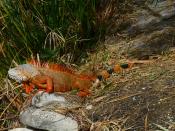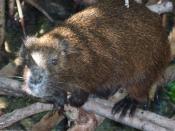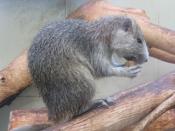There are some eighty species of reptiles in Cuba, and a wide variety of rodents. Cuban reptiles are not poisonous. The JutÃÂa (Hutia), which is a large rat like rodent, can be found throughout the island. The largest jutÃÂa in Cuba is called the "Conga." Unfortunately, these animals are edible and are close to extinction. Other smaller jutÃÂas found on the island are the "Carabali" and the "Andaraz."
Just this year, Rafael Borroto from the Institute of Technology and Systemics from the Ministry of Science, Technology and the Environment discovered a new species of an Antilles endemic rodent in Cuba.
Researchers found the alleged new species of hutia (animals of night life habits whose main diet is mainly leafs, but the new possible species' food habit is palm trunks that he gnaws up making it to fall down) in Cay Ballenato del Medio, a natural protected area of Nuevitas Bay, located more than 530 kilometers West of Havana.
Molecular tests made to the head sample of the rodent taken in 2002 revealed the significant difference with the hutia conga despite of having both a similar phenotype.
The Iguana (Iguana) which is close to extinction on the island, and which once served as a main resource of nutrition to the native Cubans, is a common Cuban land reptile. The most common iguana in Cuba is small, approximately three to four inches in length, light green, and fast-moving. The Cubans call these large sized lizards "Chipojos" and "Chipojo Ceniciento". There is also a varied amount of lagartijas or lizards on the island, also called "caguayos" in different areas of Cuba. These reptiles serve a tremendous role in controlling the insect population since they live on small insects like flies and mosquitoes that are so abundant in tropical areas.
In Cuba they're as an abundance of Cocodrilo (Crocodiles), especially in the muddy waters of the lagoons and at the mouth of most rivers. There are two species of crocodiles, the Crocodylus Rhombifer and the Crocodylus Americanus, commonly refered to as "caiman."
The Maja (Thick-bodied Snake) which is a non-poisonous reptile. The largest maja in Cuba is located in the town of Santa Maria with a length of about 9 feet. There are other, much smaller majaes in Cuba known as "jubos" which are approximately 3 feet in length. These are also non-poisonous snakes. Hope I taught you something!



Okay....
I thought that you were very informative, but failed to use colorful words. True, this isn't a descriptive essay, but you might want to try and use words that capture your audience. I still say it was a good essay though!
1 out of 1 people found this comment useful.